Complete replacement of live feeds will require long-term R&D
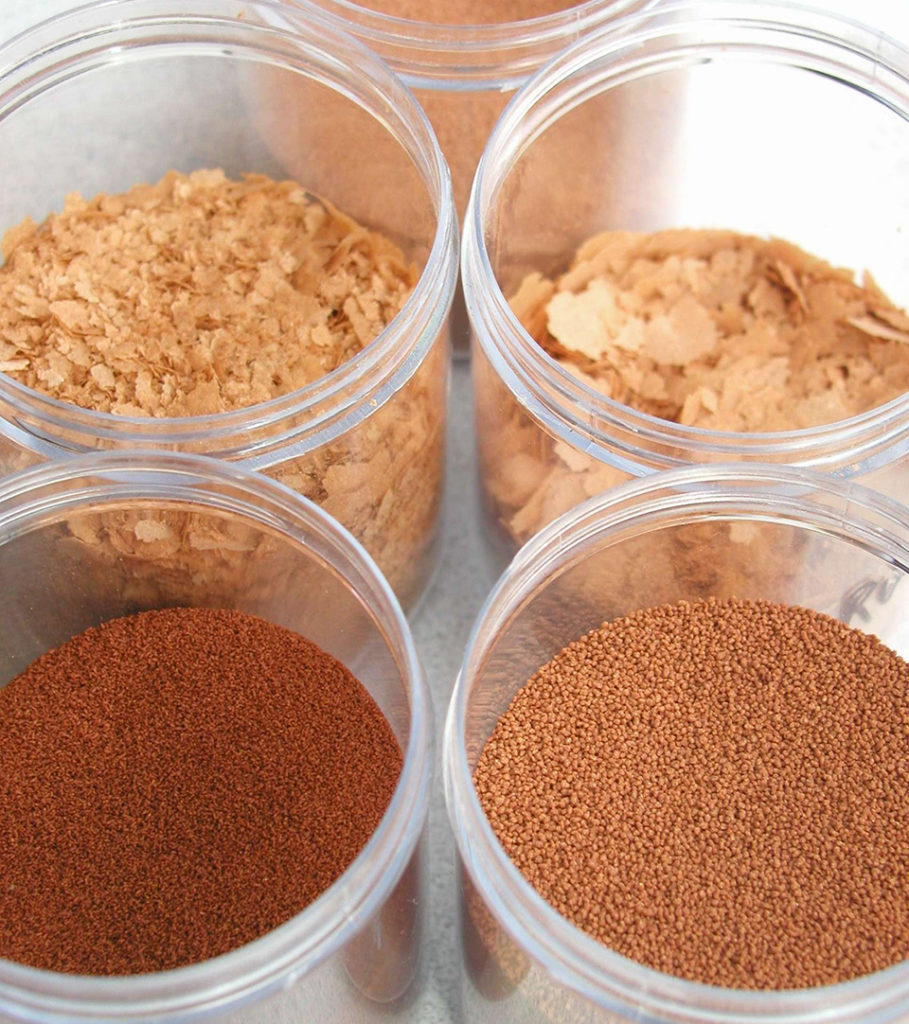
A stable supply of high-quality postlarvae (PL) is an essential requirement to guarantee the future sustainability of shrimp production. Hatchery production has become the principal source of PLs for the industry. It is estimated that in 2002, more than 11,500 hatcheries produced 220,000 million PLs worldwide.
As the supply of PLs has increased, more attention has been placed on their quality, rather than simply quantity. Growing good-quality PLs requires the use of quality feeds and optimal feeding protocols. It is no surprise that in the 2001 Global Shrimp OP survey by the Global Aquaculture Alliance, responding shrimp hatchery technicians gave top priority to research and development in the area of nutrition.
As the industry moves toward greater levels of control and the use of domesticated stocks, greater demands will be made on nutrition to support optimum performance. To date, much work has been done to improve general husbandry and impose better health management for broodstock and larval shrimp, but the heavy dependence on live food organisms in the field of larval nutrition suggests there is still a great deal to be done before diets can be optimized for consistently good performance.
Formulated larval feeds
Typically, larval stages of marine species are fed live feeds such as algae, zooplankton, rotifers and artemia. Although live feeds provide an excellent source of nutrition, several drawbacks are associated with their use.
Algal cultures require considerable expertise to maintain peak nutritional condition, and facilities for their mass production can be expensive to operate. Rotifers require considerable expenditures in time and effort to maintain, and live artemia nauplii suffer from inconsistent supply.
In recent years, low market prices for shrimp PL and the fluctuating cost of live food have led many hatchery technicians to drastically cut the use of artemia cysts. When combined with the use of inadequate replacement feeds, this has often resulted in low survival and poor postlarval quality.
In some cases, especially with rotifers and artemia, fatty acid profiles are inadequate, particularly with regard to the highly unsaturated fatty acids (HUFAs). The practice of enrichment has been developed as a means of overcoming this nutritional deficiency.
Enrichment usually involves enhancing the docosahexaenoic (DHA) and eicosapentaenoic acid (EPA) content of the natural feed through “bioencapsulation.” The live organisms are fed a DHA/EPA-enriched formulation to boost the levels in their tissues, and the enriched organisms are then fed to the larvae. In shrimp larvae, the use of enriched artemia is restricted to the postlarval stages due to the big size of the first-feeding instar stages of the artemia.
The development of formulated larval diets that completely replace live feeds has been an elusive goal, despite considerable effort. The difficulties inherent in providing a complete nutritional package in particles that are sufficiently small to be ingested and digested by the small larvae of many marine species are clear. Loss of nutrients from such diets can be rapid and result in a loss of nutritional value and fouling of the culture medium. On the other hand, the provision of a sufficiently impermeable coating to prevent leaching may result in poor digestibility and availability of the nutrients to the developing larvae.
Feed types
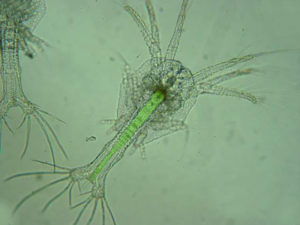
Various types of commercial larval feeds are available in the market. These include microbound diets, flakes, granulated feeds, microencapsulated feeds and liquid feeds. Microbound feeds use a variety of binders to produce a small particle that is crumbled to the appropriate size. Flakes are commonly used in Asia and the Americas.
To produce flakes, dietary ingredients are added to water to obtain a dense soup, with the resulting suspension pumped onto a steam-drum dryer. Large flakes can be crushed and passed through an appropriate mesh screen immediately prior to use.
Granulated feeds are produced using liquid binders and water sprayed onto the feed mix, resulting in granules with a raspberry-like structure. Microencapsulated feeds have an outer capsule coating that retains the ingredients inside. Liquid feeds are essentially a slurry of particles in a suspension medium.
Nutritional composition and feed particle characteristics like feed flavor, palatability, particle sedimentation and water stability are affected in a considerable manner by the type of feed processing applied by the feed manufacturer.
Considerations for feed development
The nutrition of marine larvae involves an understanding of the behavioral, mechanical and physiological processes of feeding in the target animal. These are likely to be very different in the larval stages compared to adult forms. Feeding habits in many species show distinct changes as the larvae develop.
In penaeid shrimp, many species change from a primarily herbivorous diet in the zoea stages to a more omnivorous diet in the postlarval stages. During the postlarval and early juvenile stages, further changes can involve a switch to a more carnivorous or detritivorous diet, depending on the species. Additional changes to be considered within a few days of hatching are those from a planktonic to benthic existence, and from filter feeding to active predation.
One of the key considerations is the development of the gut structure and function. Larval crustaceans have a simple gut structure that gradually becomes more complex. The physiology of the gut and gut enzymes also changes and, since transit times may be quite short, designing a nutritious, easily digestible diet is a challenge.
Lipids
Much work on larval feeds has centered on the requirements for HUFAs and phospholipids. Both DHA and EPA are essential for the normal growth and development of many species of marine fish and crustaceans. Although quantitative requirements for essential fatty acids have been rarely reported for penaeid shrimp larvae, 1 percent omega-3 HUFA in the diet could be considered a minimal value for PL.
Although there is little doubt that crustacean larvae can synthesize phospholipids from HUFAs, the addition of dietary sources of phospholipid has been shown beneficial, possibly through enhancing the absorption of dietary cholesterol and triacylglycerols.
There seems to be no requirement for phosphatidyletanolamine or phosphatidylinositol in the presence of adequate dietary phosphatidylcholine. Pacific white shrimp (Litopenaeus vannamei) PL fed diets containing phospholipid demonstrated improved growth, although other phospholipids in lecithin could not compensate for phosphatidylcholine deficiency.
In larval kuruma shrimp (Penaeus japonicus), optimal metamorphosis was obtained with diets containing 15 to 30 grams per kilograms soybean phosphatidylcholine, with the 15 grams per kilograms level more beneficial to PLs. The phospholipid requirement of crustacean larvae appears to be within the 1 to 3 percent range.
Protein and amino acids
The optimal dietary protein levels in larval diets can be expected to vary with species, larval stage, protein source, digestibility and amino acid composition. Recommended protein levels in larval feeds vary 23 to 57 percent. Table 1 provides an overview of the nutrient profiles reported on labels and technical sheets of commercial shrimp feeds.
Wouters, Estimated composition of dry commercial shrimp feeds, Table 1
| Estimated Composition | Zoea-Mysis Feeds | Number Samples | Postlarvae Feeds | Number Samples |
|---|
Estimated Composition | Zoea-Mysis Feeds | Number Samples | Postlarvae Feeds | Number Samples |
|---|---|---|---|---|
| Protein (% of dry weight) | 45-57 | 11 | 43-60 | 41 |
| Lipid (%) | 10-29 | 11 | 3-19 | 40 |
| Ash (%) | 7-18 | 11 | 5-16 | 38 |
| Starch (%) | 2-12 | 6 | 1-21 | 19 |
| Fiber (%) | – | 3 | 1.2-9.4 | 12 |
| Moisture (%) | 3-8 | 9 | 3-11 | 33 |
| HUFA (mg/g) | 2.5-3 | 7 | 2-3 13 | |
| DHA (mg/g) | 1.3.2 | 7 | 0.14-1.3 | 23 |
| EPA (mg/g) | 1.1-5 | 7 | 0.12-6 | 22 |
| Vitamin C (mg/kg) | 1,000-4,500 | 5 | 975-4,500 | 14 |
| Vitamin E (mg/kg) | 400-500 | 5 | 150-500 | 15 |
| Calcium (%) | – | 0.7-5 | 10 | |
| Phosphorus (%) | – | 0.5-2.1 | 10 |
Reported differences in protein requirements according to the larval stages of L. vannamei and Atlantic white shrimp (L. setiferus) are estimated from 30 percent in the zoea stages up to 50 to 60 percent for mysis stages. Optimal protein:energy ratios and amino acid profiles for larval shrimp feeds have not been reported.
The essential amino acids for shrimp are thought to be methionine, arginine, threonine, tryptophan, histidine, isoleucine, leucine, lysine, valine and phenylalanine.
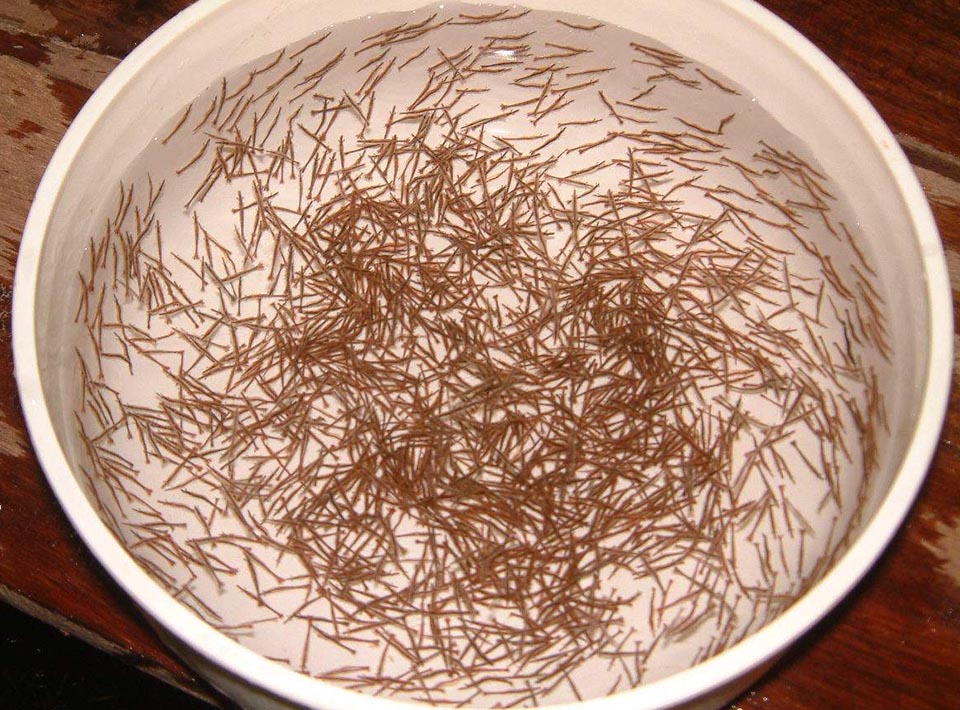
Vitamins and minerals
Fat-soluble and water-soluble vitamins, as well as carotenoids are essential for shrimp larvae. Vitamin deficiency can lead to different symptoms, but ultimately causes low survival.
Basal vitamin requirements have been reported for P. japonicus (Table 2), but these estimates can be affected by leaching of the vitamins from test diets. In practice, formulated feeds for shrimp larvae contain a complete vitamin and mineral premix as used in feeds for older shrimp.
Wouters, Basal vitamin requirements, Table 2
| Vitamin | Amount (mg/kg dry diet) |
|---|
Vitamin | Amount (mg/kg dry diet) |
|---|---|
| Thiamine HCl | 4 |
| Riboflavin | 8 |
| Pyridoxine HCl | 12 |
| Nicotinic acid | 40 |
| Biotin | 0.2 |
| Choline chloride | 600 |
| Inositol | 200 |
| Na-ascorbate | 1,000 |
| Tocopherol | 20 |
The original work on vitamin C requirements was conducted using sodium ascorbate rather than L-ascorbyl-2-polyphosphate. Although there is little data on larval nutrition using this form of vitamin C, the vitamin C requirements for production of postlarval shrimp are reported to be a minimum 20 and 130 mg AA per kilogram diet for P. monodon and L. vannamei, respectively, while a level of 2,000 mg AA per kilogram diet is needed to enhance the resistance of the shrimp postlarvae to stress conditions and bacterial infections.
Carbohydrates, nucleotides
As with adult crustaceans, there appear to be no specific requirements for carbohydrates in the diet. Carbohydrates can be used to reduce feed costs through protein or lipid sparing and are frequently used as binders in larval feeds.
Nucleotides have demonstrated much potential when fed to the young or juvenile stages of vertebrates. The potential benefits of adding dietary nucleotides to feeds for rapidly developing larval stages of crustaceans would appear similar. However, no research data is available on the application of exogenous nucleotides for crustacean larval culture.
Conclusion
Although basic knowledge exists to enable the proper formulation of larval shrimp feeds, continued research is needed to make further progress. Also, feed particle characteristics should be designed to respond to the specific needs of different species, stages, and culture conditions by the correct choice of feed-processing technique.
The complete replacement of live feeds by formulated diets has been reported but is not possible to apply widely on a commercial scale while maintaining consistent postlarvae performance and quality. Given the inherent complexities of supplying a complete nutritional package in a small particle, this goal will likely require further long-term research and development.
(Editor’s Note: This article was originally published in the June 2004 print edition of the Global Aquaculture Advocate.)
Now that you've reached the end of the article ...
… please consider supporting GSA’s mission to advance responsible seafood practices through education, advocacy and third-party assurances. The Advocate aims to document the evolution of responsible seafood practices and share the expansive knowledge of our vast network of contributors.
By becoming a Global Seafood Alliance member, you’re ensuring that all of the pre-competitive work we do through member benefits, resources and events can continue. Individual membership costs just $50 a year.
Not a GSA member? Join us.
Authors
-
Roeland Wouters, Ph.D.
INVE Technologies N.V.
Hoogveld 93, B-9200 Dendermonde
Belgium -

Daniel F. Fegan
Alltech Inc.
Bangkok, Thailand
Tagged With
Related Posts
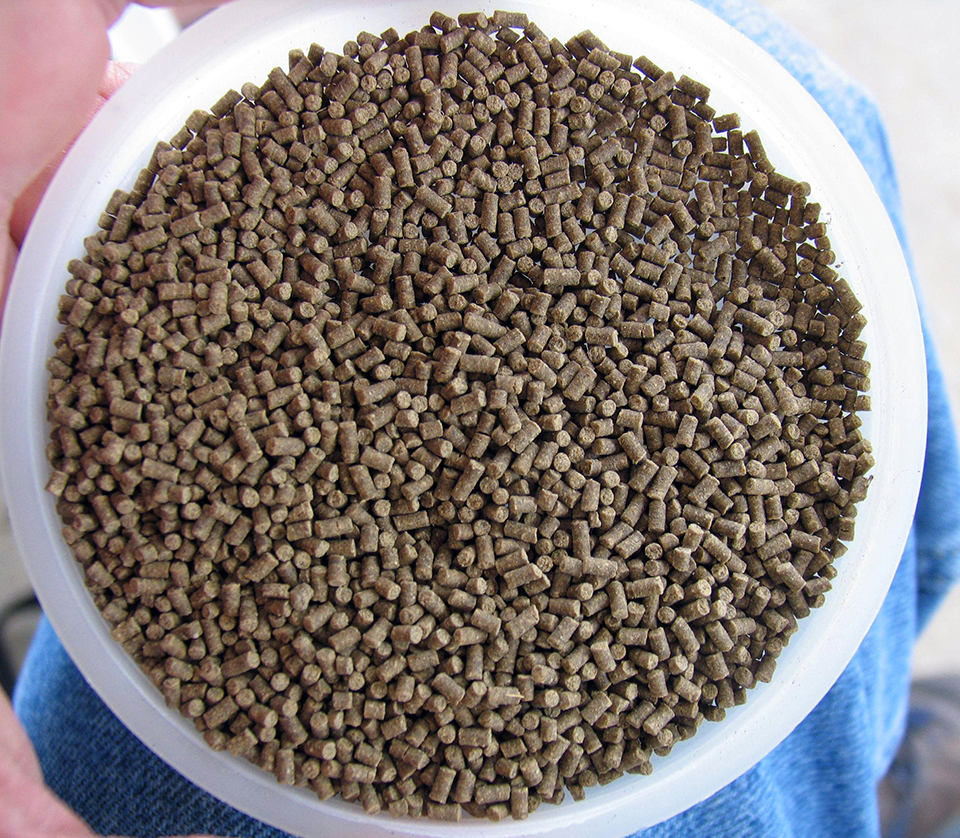
Health & Welfare
A case for better shrimp nutrition
Shrimp farm performance can often be below realistic production standards. Use proven nutrition, feeds and feeding techniques to improve profitability.

Aquafeeds
A look at protease enzymes in crustacean nutrition
Food digestion involves digestive enzymes to break down polymeric macromolecules and facilitate nutrient absorption. Enzyme supplementation in aquafeeds is a major alternative to improve feed quality and nutrient digestibility, gut health, compensate digestive enzymes when needed, and may also improve immune responses.
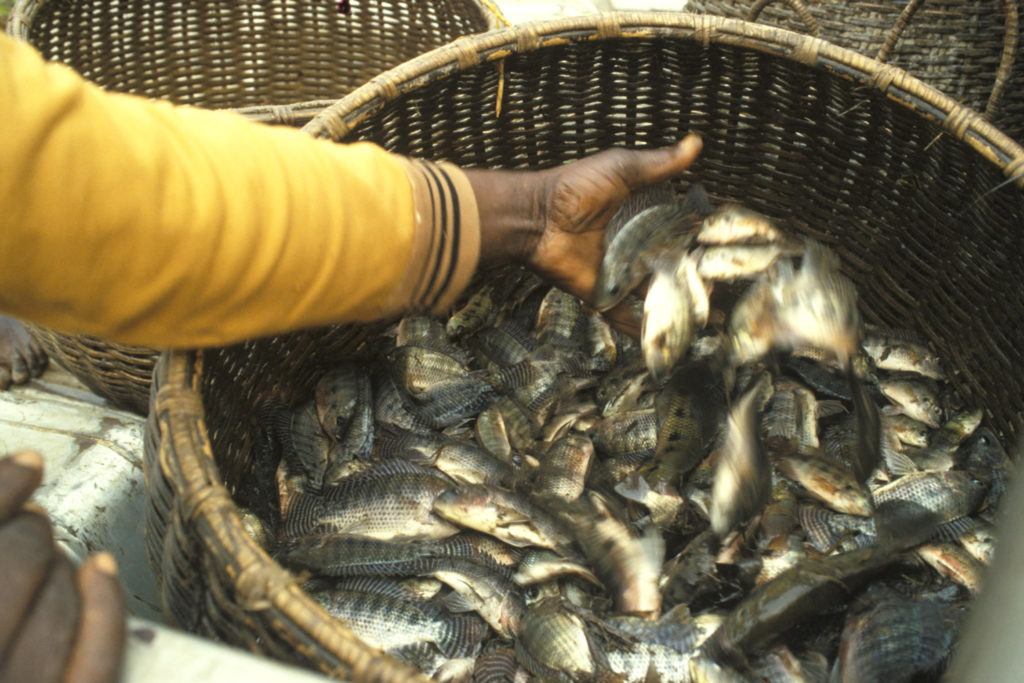
Responsibility
A helping hand to lend: UK aquaculture seeks to broaden its horizons
Aquaculture is an essential contributor to the world food security challenge, and every stakeholder has a role to play in the sector’s evolution, delegates were told at the recent Aquaculture’s Global Outlook: Embracing Internationality seminar in Edinburgh, Scotland.

Aquafeeds
A look at phospholipids in aquafeeds
Phospholipids are the major constituents of cell membranes and are vital to the normal function of every cell and organ. The inclusion of phospholipids in aquafeeds ensures increased growth, better survival and stress resistance, and prevention of skeletal deformities of larval and juvenile stages of fish and shellfish species.


